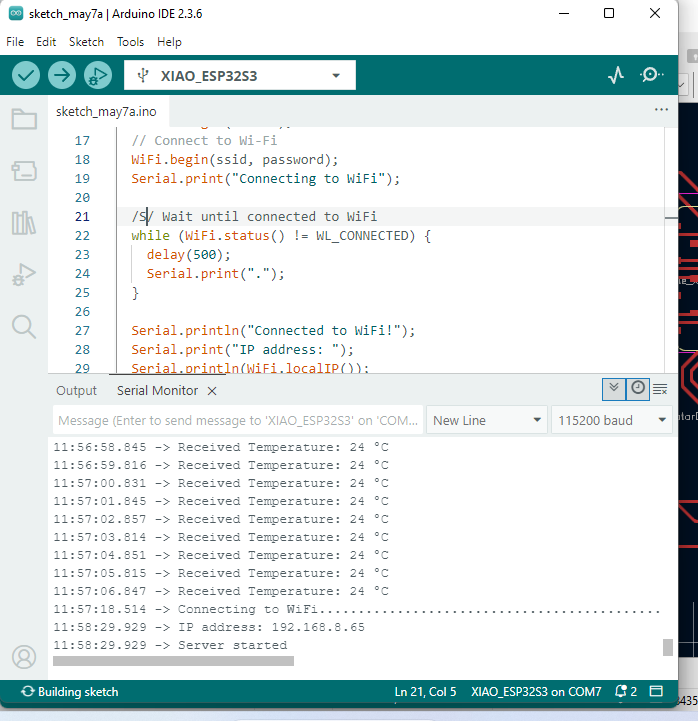
git
Git is a distributed version control system that tracks changes in any set of computer files.
For this week, I explored device-to-device communication using the I²C (Inter-Integrated Circuit) protocol. I connected a Seeed Studio XIAO RP2040 as the master device and a XIAO ESP32S3 as the slave.
I²C is a synchronous, multi-master, multi-slave, packet-switched, single-ended, serial communication bus. It uses only two lines for communication:
Each device on the I²C bus has a unique 7-bit address. The master controls the clock and initiates communication, while slaves respond to requests. It is commonly used for short-distance communication between microcontrollers and sensors.
The wiring between the XIAO RP2040 (master) and XIAO ESP32S3 (slave) was as follows:
Pull-up resistors (4.7kΩ–10kΩ) were added to SDA and SCL lines.
The RP2040 sends a message to the ESP32S3 using the Wire library.
const int THERMISTOR_PIN = A3;
const float SERIES_RESISTOR = 10000; // 10k resistor
const float NOMINAL_RESISTANCE = 10000; // 10k at 25C
const float NOMINAL_TEMPERATURE = 25;
const float B_COEFFICIENT = 3950;
const int ADC_MAX = 4095;
void setup() {
Serial.begin(115200);
}
void loop() {
int adcValue = analogRead(THERMISTOR_PIN);
float voltageRatio = (float)adcValue / ADC_MAX;
float resistance = SERIES_RESISTOR * (1.0 / voltageRatio - 1.0);
float steinhart = resistance / NOMINAL_RESISTANCE;
steinhart = log(steinhart);
steinhart /= B_COEFFICIENT;
steinhart += 1.0 / (NOMINAL_TEMPERATURE + 273.15);
steinhart = 1.0 / steinhart;
steinhart -= 273.15;
Serial.print("Temperature: ");
Serial.print(steinhart);
Serial.println(" °C");
delay(1000);
}
The ESP32S3 receives the message using the Wire library in slave mode.
#include
#include
#include
// WiFi Configuration
const char* ssid = "FABLAB";
const char* password = "fablab@2023";
// I2C Configuration
#define I2C_ADDR 0x08
#define SDA_PIN D4
#define SCL_PIN D5
WebServer server(80);
float currentTemp = 0.0;
unsigned long lastUpdate = 0;
// Forward declarations of functions
void handleRoot();
void handleTemperature();
void handleUpdate();
void updateTemperature();
void setup() {
Serial.begin(115200);
// Initialize I2C
Wire.begin(SDA_PIN, SCL_PIN);
// Connect to WiFi
WiFi.begin(ssid, password);
Serial.print("Connecting to WiFi");
while (WiFi.status() != WL_CONNECTED) {
delay(500);
Serial.print(".");
}
Serial.println("\nConnected! IP: " + WiFi.localIP().toString());
// Setup web server routes
server.on("/", handleRoot);
server.on("/temperature", handleTemperature);
server.on("/update", handleUpdate);
server.begin();
Serial.println("HTTP server started");
}
void loop() {
server.handleClient();
// Update temperature every second
if (millis() - lastUpdate >= 1000) {
updateTemperature();
lastUpdate = millis();
}
}
void updateTemperature() {
Wire.requestFrom(I2C_ADDR, sizeof(float));
if (Wire.available() == sizeof(float)) {
byte tempBytes[sizeof(float)];
for (int i = 0; i < sizeof(float); i++) {
tempBytes[i] = Wire.read();
}
currentTemp = *((float*)tempBytes);
Serial.printf("Updated temperature: %.2f°C\n", currentTemp);
} else {
Serial.println("Error reading from I2C");
}
}
void handleTemperature() {
String json = "{\"temp\": " + String(currentTemp) + "}";
server.send(200, "application/json", json);
}
void handleUpdate() {
updateTemperature();
server.send(200, "text/plain", "Temperature updated");
}

"Temperature Recieved from XIAO RP2040".This week introduced me to communication between microcontrollers using the I²C protocol. I learned how to set up master/slave roles, configure addresses, and send data. This method is scalable and useful for sensor networks or distributed control systems.